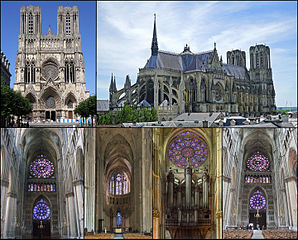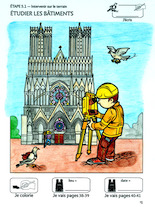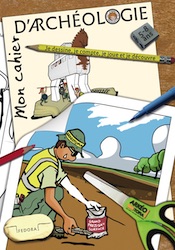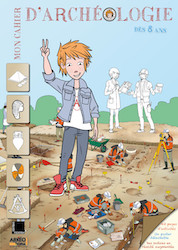Building Archaeology, A Little-known Specialization
- Last Updated: Tuesday, 28 June 2022 09:37
- Published: Sunday, 22 May 2022 11:24
- Written by Jean-Olivier Gransard-Desmond translated by L. Gallet and M. Schmitt
- Hits: 1746
Join Augustin, Alex, Lisa and the whole ArkeoTopia team to discover additional resources for step 5.1 in My Archaeology Book about fieldwork and the study of above-ground structures that are still standing in the present day.
Step 5.1 - Fieldwork
Building Archaeology
Corresponding pages in MAB1 and MAB2
MAB 1, p.15 and MAB 2, p.19
More about this step’s reference artifact

 The drawing on pages 15 and 19 in My Archaeology Book, titled Building Archaeology, was inspired by the Reims Cathedral. Building archaeology encompasses a variety of different procedures that allow archaeologists to analyze above-ground architectural relics, many of which are still in use.
The drawing on pages 15 and 19 in My Archaeology Book, titled Building Archaeology, was inspired by the Reims Cathedral. Building archaeology encompasses a variety of different procedures that allow archaeologists to analyze above-ground architectural relics, many of which are still in use.
The Reims Cathedral, or the Cathedral of Notre-Dame in Reims, is located in the Grand Est region of France and was constructed on rue du Trésor from 1211-1275 CE. Designated as a Historic Monument in 1862, the Cathedral was also inducted as a UNESCO World Heritage Site in 1991.
The Reims Cathedral is a Gothic art masterpiece, constructed in the 13th century using cutting-edge architectural techniques for its time, as well as a unique style blending architectural elements with sculpted decorations. The Cathedral is also well-known as the coronation site for the majority of French kings: between 1027 and 1825, 30 French kings were crowned there. This explains why the Palace of Tau, an ancient archiepiscopal palace, was entirely renovated in the 17th century – in order to house the kings before and after the ceremony. The nearby former abbey boasts a beautiful nave from the 11th century, which houses the remains of Archbishop Saint Rémi (440-533), responsible for the advent of holy anointment for French kings. Another feature of note is the Cathedral’s labyrinth.
The Cathedral is also well-known as the coronation site for the majority of French kings: between 1027 and 1825, 30 French kings were crowned there. This explains why the Palace of Tau, an ancient archiepiscopal palace, was entirely renovated in the 17th century – in order to house the kings before and after the ceremony. The nearby former abbey boasts a beautiful nave from the 11th century, which houses the remains of Archbishop Saint Rémi (440-533), responsible for the advent of holy anointment for French kings. Another feature of note is the Cathedral’s labyrinth.
Alex and Lisa’s building archaeology study of the Reims Cathedral demonstrates that archaeologists’ work is not limited to excavation. Many buildings that are still standing require above-ground analyses, including wash houses, sheds and old abandoned factories. Buildings that are still in use are also subject to study by archaeologists, including churches and town halls. This kind of work is known as building archaeology.
Building archaeology seeks not only to illustrate the architecture of a building, but also to understand it. Which parts of the building correspond to what eras of history? Has a portion of the building been renovated? Do the elevations or vertical projections, such as walls or other façades, reveal stratigraphy that has gone unnoticed until now? In this case, stratigraphy is not conducted on layers of earth, as seen in a title="Compare with stratigaphy during an excavation like on Step 5.2 of My Archaeology Book" href="/en/resources/97-augustin-world/553-archaeologists-are-food-lovers.html">Step 5.2, but rather into wall elevations, as seen in the video.
Archaeologists must ask many questions in order to understand how these buildings were built and maintained. In the drawing, Alex and Lisa the archaeologists can be seen doing a ground survey to prepare the site, just as they would prior to an excavation. For this project, they will also need to survey the Cathedral’s façades. While Flash the pigeon sends information and useful notes to the lab, Alex uses a Total Station (TS) and Lisa a topographer's rod in order to conduct a topographical survey. This survey will provide them with a 3D view of the façade, and from there they will be able to reconstruct the chronology of the façade’s construction.
In the drawing, Alex and Lisa the archaeologists can be seen doing a ground survey to prepare the site, just as they would prior to an excavation. For this project, they will also need to survey the Cathedral’s façades. While Flash the pigeon sends information and useful notes to the lab, Alex uses a Total Station (TS) and Lisa a topographer's rod in order to conduct a topographical survey. This survey will provide them with a 3D view of the façade, and from there they will be able to reconstruct the chronology of the façade’s construction.
Clues
The 5 clues include:
- The Reims Cathedral, which represents both French cultural heritage and an important archaeological site, despite its continued use as a place of worship
- Lisa and Alex the archaeologists, wearing their construction gear, who represent scientific study using building archaeology in order to better understand the history of the building and the chronology of its construction
- The Total Station (TS) Alex is using represents the tools archaeologists need in order to properly measure and analyze the building
- The topographer’s rod Lisa is holding represents the tools archaeologists need in order to properly measure and analyze the building
- Flash, the pigeon, who ensures that information is transmitted through the air from the field to the laboratory
 |
 |
|
My Archaeology Book 1 |
My Archaeology Book 2 |

 My Archaeology Book, or MAB, is an activity workbook that combines creativity, fun and learning. Alongside young Augustin, a curious and courageous boy, children meet Alex and Lisa, two friendly archaeologists who will lead them to discover archaeology and French heritage. Each drawing illustrates a situation that Alex and Lisa might encounter at work. Depending on the age of the child and the workbook, children follow easy-to-understand symbols in order to experiment with activities such as coloring, drawing, observation games, riddles and reading in order to see the world through an archaeologist’s eyes. Alone, with family, at school or just for fun, children expand their knowledge and gain skills, all while having fun.
My Archaeology Book, or MAB, is an activity workbook that combines creativity, fun and learning. Alongside young Augustin, a curious and courageous boy, children meet Alex and Lisa, two friendly archaeologists who will lead them to discover archaeology and French heritage. Each drawing illustrates a situation that Alex and Lisa might encounter at work. Depending on the age of the child and the workbook, children follow easy-to-understand symbols in order to experiment with activities such as coloring, drawing, observation games, riddles and reading in order to see the world through an archaeologist’s eyes. Alone, with family, at school or just for fun, children expand their knowledge and gain skills, all while having fun.
On this section, you will find additional resources: color photos of archaeological documents that inspired My Archaeology Book, additional teaching documents (flip-book, websites, suggestions for classroom use, edutainement, etc.) and information on upcoming publications. Each page will be updated over time.






